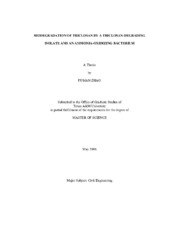| dc.description.abstract | Triclosan is incorporated in a wide array of medical and consumer products as an antimicrobial agent or preservative. Disposal of these products transport triclosan into wastewater and later into soils and surface waters. Due to incomplete removal of triclosan in wastewater treatment plants, contamination of triclosan in the environment has raised several concerns, including: (i) an aid to the development of cross-resistance to antibiotics, (ii) the toxicity to ecological health, (iii) the formation of chlorodioxins from triclosan and its metabolites. By using 14C-labeled triclosan, 14CO2 was observed in activated sludge samples, suggesting that triclosan was biodegraded. However, little is known about the microorganisms responsible for triclosan biodegradation in activated sludge. The goal of this study is to better understand biodegradation of triclosan in activated sludge. Two specific objectives are: (i) isolating and characterizing triclosan-degrading bacteria from activated sludge, (ii) characterizing the cometabolic degradation of triclosan through an ammonia-oxidizing bacterium Nitrosomonas europaea. A triclosan-degrading strain, KCY1, was successfully isolated from the activated sludge. The strain KCY1 completely degraded triclosan in three days when OD600 was 0.4. Based on 16S rRNA analysis, the strain KCY1 has 97% similarity with Phingomonas or Phingopyxis. Negative results of oxygenase activity assays suggested that other enzymes rather than oxygenases might be responsible for the triclosan biodegradation. Experiments using N. europaea showed that triclosan could be cometabolized. In the presence of inhibitor for ammonia monooxygenase (AMO), N. europaea was unable to degrade triclosan, suggesting that AMO might be responsible for triclosan degradation. Triclosan appeared to competitively inhibit ammonia oxidation by N. europaea. Results of this study showed that triclosan might be effectively biodegraded by triclosan-degrading cultures, strain KCY1 and N. europaea. | en |


